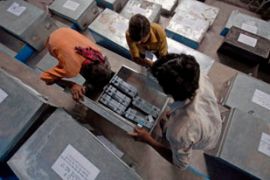India election gets under way
Heavy security deployed as the world’s most populous democracy goes to the polls.

In the eastern state of Jharkhand, five Maoists and two security personnel were killed in a firefight, while in neighbouring Bihar, about a dozen fighters were killed and several policemen wounded.
| Special report |
 |
The Maoists, who say they are fighting for the rights of poor farmers and landless labourers, have called for a boycott of the election and blocked roads to prevent officials from reaching polling stations.
Manmohan Singh, the Indian prime minister, has described Maoist violence as the country’s biggest internal security threat.
More than two million officers have been deployed to prevent unrest during the elections, which will end on May 13.
Results of the election, which will use more than 1.3 million electronic voting machines in 828,804 polling stations, are expected on May 16.
Coalition trading
Neither of the two main national parties – the incumbent Congress party and the Bharatiya Janata Party (BJP) – is seen as capable of securing an absolute majority at the end of the lengthy process.
With a myriad of other parties expected to take up to 50 per cent of the 543 seats in the parliament – or Lok Sabha – the final result will kick off an intense period of political horse-trading as the major players rush to form a coalition.
| In depth |
|
Voting takes place in 543 constituencies in five phases from April 16 to May 13. Results declared on May 16.
Total constituencies: 124
Total constituencies: 141
Total constituencies: 107
Total constituencies: 85
Total constituencies: 86 |
Reporting from Varanasi in Uttar Pradesh, the country’s most populous state, Al Jazeera’s Matt McClure said: “India’s parliament is likely to look very different from the current one.
“The Congress party here is facing a stiff challenge from the Hindu nationalist BJP, but it is also being challenged by two smaller, regional, caste-based parties – the Samajwadi party and the Bahujan Samaj Party, who many people here have said they are considering voting for.”
Singh said on Wednesday that he would be open to renewing an alliance with communist parties after the election despite an angry split last year over a civilian nuclear deal signed with the US.
The prospect of a shaky coalition of disparate allies is a turn-off for most Indian voters, with any new government likely to face national security concerns and a sharp economic slowdown after years of soaring growth.
The only viable alternative to a Congress- or BJP-led coalition is provided by a loose alliance of left-leaning and regional parties called the Third Front, which is lead by the communists.
Reporting from the south Indian state of Kerala, Al Jazeera’s Barnaby Phillips said: “Certainly as far as Congress is concerned, the left are saying, no, they will not work with them.
“Having said that, politics is politics … The left itself is very fractured and I’ve no doubt that there will be some people within it who would be tempted by a return to power if that were on offer.”
Many of India’s voters are expected to make their choices along religious and caste lines or on the basis of a strictly regional issue.
Congress, ending a five-year period in power, has seen its main achievement – economic growth averaging more than eight per cent in recent years – hit by the global economic crisis.
In Amethi, a rural constituency represented by Rahul Gandhi, the son of Sonia Gandhi, the Congress party chief, voters lamented the lack of basic facilities such as electricity, water and roads.
In contrast, the glittering shopping malls in India’s bustling cities show that those who have benefited most from India’s economic development are a growing urban middle class, while millions of poor are being left behind.
Ageing leaders
The election campaign is also focusing on the confrontation between the two prime-ministerial candidates of this election – Singh and LK Advani of the BJP.
Incumbent Manmohan is 76-years old and Advani is 81.
Advani has publicly accused Singh of being a weak prime minister, saying that “he has devalued this post”.
The normally mild-mannered Singh has also criticised Advani, recalling his role in the controversial demolition of a mosque in 1992 and the anti-Muslim riots that occurred when the party was last in power.
Singh, an Oxford-educated economist, was picked by Gandhi to be prime minister after the 2004 elections.
 Phase I
Phase I